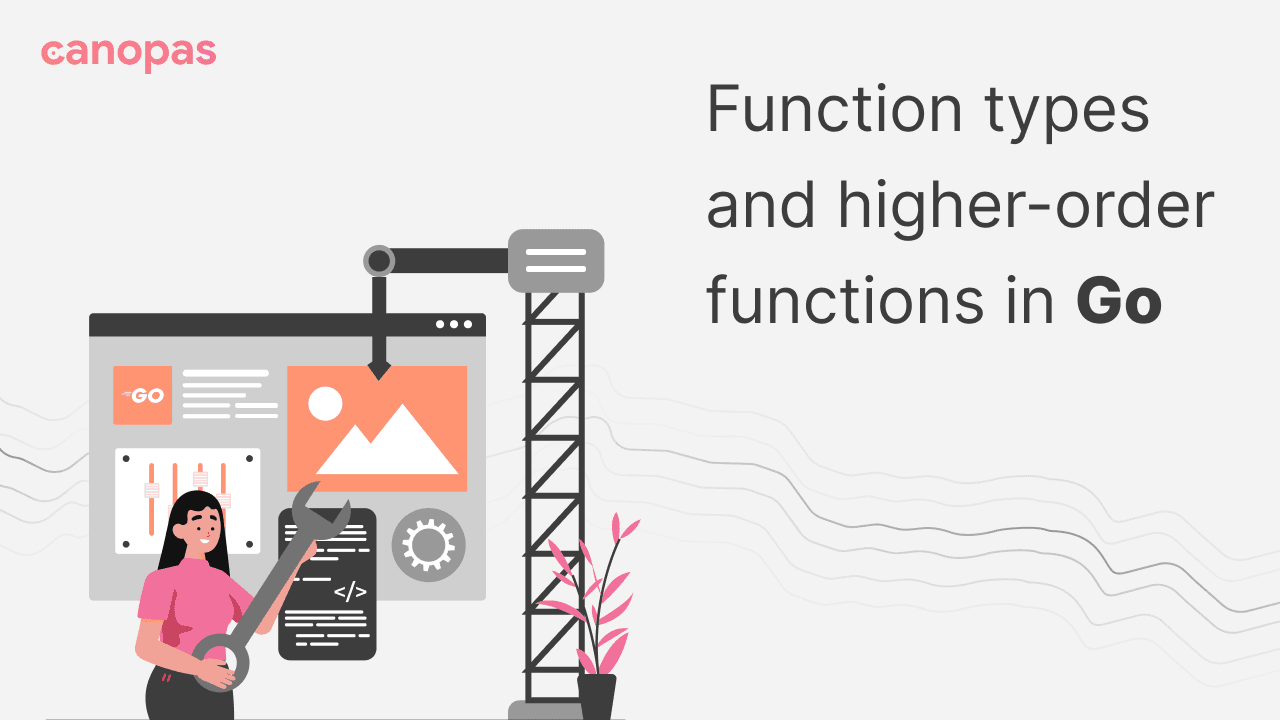
Function Types and Higher-Order Functions in Go
Introduction
In the world of programming, the ability to treat functions as first-class citizens opens up a plethora of possibilities.
Go, with its support for first-class functions and function types, empowers developers to write cleaner, more modular, and flexible code.
When we say, functions are considered first-class citizens, we mean it.
It means they can be assigned to variables, passed as arguments to other functions, and returned from functions. This capability stems from the ability to define function types.
In this blog post, we’ll delve into the concepts of function types and higher-order functions in Go, exploring how they can be defined, utilized, and leveraged to enhance the efficiency and readability of your codebase.
Sponsored
We are what we repeatedly do. Excellence, then, is not an act, but a habit. Try out Justly and start building your habits today!
What are higher-order functions?
Higher-order functions are functions that either take other functions as arguments, return functions, or both. They enable developers to write more generic and reusable code.
Let’s explore the use cases where we can use higher-order functions.
Callbacks
Suppose we have a function that performs some operation on each element of a list.
This function can use another function as an argument that performs the desired operation on the list, instead of directly performing it from the function.
It can be a better candidate when we want to perform different operations in the same function based on conditions.
package main
import "fmt"
func Process(list []int, callback func(int)) {
for _, item := range list {
callback(item)
}
}
func main() {
numbers := []int{1, 2, 3, 4, 5}
Process(numbers, func(num int) {
fmt.Println(num * 2)
})
}
// Output
2
4
6
8
10Anonymous Functions
Anonymous functions can be used inline wherever a function value is expected.
For example, sorting strings by their length using an anonymous function.
package main
import (
"sort"
"fmt"
)
func main() {
words := []string{"apple", "banana", "orange", "grape"}
sort.Slice(words, func(i, j int) bool {
return len(words[i]) < len(words[j])
})
fmt.Println(words) // Output: [apple grape banana orange]
}Advantage: It offers a concise and flexible way to define functions inline, eliminating the need for separate function declarations.
Closure
Closures capture the surrounding state, allowing for the encapsulation of variables.
Here’s an example where a closure is used to maintain state across multiple invocations.
package main
import "fmt"
func counter() func() int {
count := 0
return func() int {
count++
return count
}
}
func main() {
increment := counter()
fmt.Println(increment()) // Output: 1
fmt.Println(increment()) // Output: 2
fmt.Println(increment()) // Output: 3
}Advantage: It enables the creation of self-contained units of functionality that retain access to their surrounding lexical scope.
Closures ensure the scope and lifetime of variables captured within them are preserved for the duration of their existence.
Function Composition
Function composition involves combining multiple functions to create a new one.
Here’s an example where two functions are composed to form a new one.
package main
import "fmt"
func addOne(num int) int {
return num + 1
}
func double(num int) int {
return num * 2
}
func main() {
addOneThenDouble := func(num int) int {
return double(addOne(num))
}
result := addOneThenDouble(5)
fmt.Println(result) // Output: 12
}Advantage: It empowers developers to create complex behaviors by combining simple functions in a modular and composable manner.
Error Handling
Higher-order functions can be used to propagate errors.
Here’s an example where a higher-order function is used to wrap a function and handle errors.
package main
import (
"errors"
"fmt"
)
func handleErrors(fn func() error) error {
if err := fn(); err != nil {
return fmt.Errorf("error occurred: %v", err)
}
return nil
}
func main() {
err := handleErrors(func() error {
// Simulating an operation that may return an error
return errors.New("something went wrong")
})
if err != nil {
fmt.Println("Error handled:", err)
} else {
fmt.Println("No error occurred")
}
}
// Output
Error handled: error occurred: something went wrongTesting
Mocking functions for testing can be achieved using higher-order functions.
Here’s an example where a mock function is passed to a function under test.
package main
import "fmt"
type DependencyFunc func(int) int
func FunctionUnderTest(dep DependencyFunc, num int) int {
return dep(num) * 2
}
func main() {
result := FunctionUnderTest(func(num int) int {
return num + 1 // Mocked dependency
}, 5)
fmt.Println(result) // Output: 12
}Advantage: It facilitates developers to write comprehensive tests for functions that accept or return other functions, ensuring the correctness and reliability of their code.
Major usability is when we want different outputs from the same function, depending upon the environment or according to the condition.
Performance Considerations
Performance can be optimized by minimizing unnecessary function calls. Here’s an example where a closure is used to reduce overhead.
package main
import "fmt"
func main() {
sum := 0
add := func(num int) {
sum += num
}
for i := 0; i < 100; i++ {
add(i)
}
fmt.Println(sum) // Output: 4950
}Advantage: It improves the efficiency and responsiveness of applications, particularly in performance-critical scenarios, by minimizing overhead and maximizing resource utilization.
Compatibility and Interoperability
Function types can be used with interfaces for compatibility.
Here’s an example where an interface is defined to work with different function types.
package main
import "fmt"
type Operator interface {
Operate(int, int) int
}
type Adder struct{}
func (a Adder) Operate(x, y int) int {
return x + y
}
type Multiplier struct{}
func (m Multiplier) Operate(x, y int) int {
return x * y
}
func main() {
var op Operator
op = Adder{}
fmt.Println(op.Operate(2, 3)) // Output: 5
op = Multiplier{}
fmt.Println(op.Operate(2, 3)) // Output: 6
}Advantage: It addresses considerations for integrating function types and higher-order functions with other language features, such as interfaces, structs, and generics.
With that said, Every coins has two sides. Higher-order functions can also have some performance impact depending upon the several factors.
It’s recommended to use the higher-order function depending upon the requirements more often. Let’s discuss some of the negative impacts it can have on performance.
Function Call Overhead
Each function call incurs some overhead, including parameter passing, stack manipulation, and return address management.
When using higher-order functions that accept or return functions, there may be additional overhead associated with passing function pointers or closures.
Closure Overhead
Closures, which capture the surrounding lexical scope, typically involve additional memory allocation and runtime overhead.
This overhead increases with the size and complexity of the captured variables and can impact performance, especially in scenarios where closures are created frequently or used in tight loops.
Inlining
In some cases, compilers may be able to inline simple higher-order functions, effectively replacing the function call with the function body.
This optimization can eliminate the overhead associated with function calls but may not always be possible, especially for more complex or dynamically generated functions.
Optimization Opportunities
Higher-order functions can introduce optimization opportunities, such as loop fusion or function specialization.
By composing multiple functions together or applying transformations to functions at runtime, developers can optimize code for better performance.
However, realizing these optimizations may require careful design and implementation considerations.
Increased Memory Usage
Higher-order functions may lead to increased memory usage, particularly when closures capture large or long-lived variables.
This can impact both memory footprint and cache locality, potentially affecting overall system performance, especially in memory-constrained environments.
Profiling and Benchmarking
Understanding the performance implications of higher-order functions requires careful profiling and benchmarking.
It’s highly recommended to measure the execution time and resource utilization of code segments with and without higher-order functions, to identify performance bottlenecks.
Conclusion
Higher-order functions either take other functions as arguments, return functions or can be used with interfaces and generics.
It provides a facility to reuse the code and manipulate the code behavior in between the executions, mocking the necessary dependencies or functionality.
Higher-order functions, while powerful and flexible, can have an impact on performance due to the overhead involved in function calls and closures.
However, the extent of this impact depends on various factors such as the frequency of function calls, the complexity of the functions involved, and the efficiency of the compiler optimizations.

